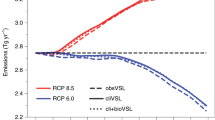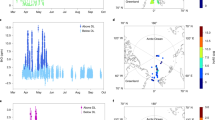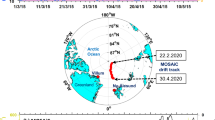Abstract
Reactive bromine species contribute significantly to the destruction of ozone in the polar stratosphere1. Reactive halogen compounds can have a strong effect not only on the chemistry of the stratosphere but also on that of the underlying troposphere. For example, severe ozone depletion events that are less persistent than those in the stratosphere occur in the Arctic2 and Antarctic3 boundary layer during springtime and are also associated with enhanced BrO abundances2,4,5,6,7,8,9,10. Observations5,6,7,8 of BrO (and ClO, which is less important) at ground level during these ozone depletion events have revealed halogen oxide mixing ratios of up to 30 parts per trillion—sufficient to destroy within one to two days the 30–40 parts per billion of ozone typically present in the boundary layer. The catalytic mechanism leading to so-called ‘tropospheric ozone holes’ is well established2,11, but the origin of the increased BrO concentrations and the spatial and temporal extent of these events remains poorly understood. Here we present satellite observations showing that tropospheric air masses enriched in BrO are always situated close to sea ice and typically extend over areas of about 300–2,000 km. The BrO abundances remain enhanced forperiods of 1 to 3 days. These observations support the suggestion7,9,10 that autocatalytic release of bromine from sea salt gives rise to significant BrO formation which, in turn, initiates ozone depletion in the polar troposphere.
This is a preview of subscription content, access via your institution
Access options
Subscribe to this journal
Receive 51 print issues and online access
$199.00 per year
only $3.90 per issue
Buy this article
- Purchase on Springer Link
- Instant access to full article PDF
Prices may be subject to local taxes which are calculated during checkout




Similar content being viewed by others
References
McElroy, M., Salawitch, R., Wofsy, S. & Logan, J. Reductions of Antarctic ozone due to synergistic interactions of chlorine and bromine. Nature 321, 795–762 (1986).
Barrie, L. A., Bottenheim, J. W., Schnell, R. C., Crutzen, P. J. & Rasmussen, R. A. Ozone destruction and photochemical reactions at polar sunrise in the lower Arctic atmosphere. Nature 334, 138–141 (1988).
Solberg, S., Schmidbauer, N., Semb, A., Stordal, F. & Øystein, H. Boundary layer ozone depletion as seen in the Norwegian Arctic in spring. J. Atmos. Chem. 23, 301–332 (1996).
Wessel, S. Troposphärische Ozonvaiationen in Polarregionen (Thesis, Univ. Bremen, 1996).
Hausmann, M. & Platt, U. Spectroscopic measurement of bromine oxide and ozone in the high Arctic during Polar Sunrise Experiment 1992. J. Geophys. Res. 99, 25399–25414 (1994).
Tuckermann, M. et al. DOAS observation of halogen radical-catalysed Arctic boundary layer ozone destruction during the ARCTOC-campaigns 1995 and 1996 in Ny Ålesund, Spitsbergen. Tellus 49 B, 533–555 (1997).
Platt, U. & Lehrer, E. ARCTOC final report to EU, Brussels (1996).
Kreher, K., Johnston, P. V., Wood, S. W. & Platt, U. Ground-based measurements of tropospheric and stratospheric BrO at Arrival Heights (78° S), Antarctica. Geophys. Res. Lett. 24, 3021–3024 (1997).
Tang, T. & McConnel, J. C. Autocatalytic release of bromine from arctic snow pack during polar sunrise. Geophys. Res. Lett. 23, 2633–2636 (1996).
Vogt, R., Crutzen, P. J. & Sander, R. Amechanism for halogen release from sea-salt aerosol in the remote marine boundary layer. Nature 383, 327–330 (1996).
Le Bras, G. & Platt, U. Apossible mechanism for combined chlorine and bromine catalyzed destruction of tropospheric ozone in the Arctic. J. Geophys. Res. 22, 599–602 (1995).
ESA Publication Division GOME, Global Ozone Monitoring Experiment, Users Manual. (ed. Floyed, B.) (European Space Research and Technology Centre (ESTEC), Noordwijk, 1995).
Hegels, E. et al. in Atmospheric Ozone, Proc. 18th Quadrenial Ozone Symp. (eds Bojkov, R. D. & Visconti, G.) 293–296 (L'Aquila, 1998).
Platt, U. in Air Monitoring by Spectroscopic Techniques (ed. Sigrist, M. W.) 127 (Chemical Analysis Ser., Wiley, New York, 1994).
Stutz, J. & Platt, U. Numerical analysis and error estimation of differential optical absorption spectroscopy measurements least-squares methods. Appl. Optics 35, 6041–6053 (1996).
Wahner, A., Ravishankara, A. R., Sander, S. P. & Friedl, R. R. Absorption cross-section of BrO between 312 and 385 nm at 298 and 223 K. Chem. Phys. Lett. 152, 507–512 (1988).
Marquard, L. C. & Platt, U. AMFTRAN: A new Monte Carlo radiative transfer model for the calculation of air mass factors. Proc. NATO ARW, Athens, Nov. 1995. (Springer, Heidelberg, London, New York, 1997).
Osterkamp., H. et al. in Air Pollution Research Report 66, Polar Stratospheric Ozone 1997, Proc. 4th European Symp. (eds Harris, N. R. P., Kilbane-Dawe, I. & Amanatidis, G. T.) 478–481 (Office for Official Publications of the European Communities, Luxembourg, 1998).
Wagner, T. et al. in Air Pollution Research Report 66, Polar Stratospheric Ozone 1997, Proc. 4th European Symp. (eds Harris, N. R. P., Kilbane-Dawe, I. & Amanatidis, G. T.) 514–517 (Office for Official Publications of the European Communities, Luxembourg, 1998).
Fortuin, J. P. F. & Orlemans, J. An Atmospheric Model for Simulating the Mass Balance and Temperature on the Antarctic Ice Sheet. Zeitschrift für Gletscherkunde und Glazialgeologie 26, 31–56 (1992).
Acknowledgements
The financial support of the Deutsche Agentur für Raumfahrtangelegenheiten (DARA) is acknowledged. We thank the ESA operation centre in Frascati (Italy) and the DLR, Department ‘Wissenschaftlich-technische Betriebseinrichtungen’ in Wessling for supplying the satellite data; C. Leue for developing the computer graphics program; L. Marquard for calculating AMFs; and A. Richter for discussion.
Author information
Authors and Affiliations
Rights and permissions
About this article
Cite this article
Platt, U., Wagner, T. Satellite mapping of enhanced BrO concentrations in the troposphere. Nature 395, 486–490 (1998). https://doi.org/10.1038/26723
Received:
Accepted:
Issue Date:
DOI: https://doi.org/10.1038/26723
This article is cited by
-
Natural short-lived halogens exert an indirect cooling effect on climate
Nature (2023)
-
Widespread detection of chlorine oxyacids in the Arctic atmosphere
Nature Communications (2023)
-
A global model study of natural bromine sources and the effects on tropospheric chemistry using MOZART4
Journal of Atmospheric Chemistry (2013)
-
Selected topics in arctic atmosphere and climate
Climatic Change (2012)
-
Modelling the multiphase near-surface chemistry related to ozone depletions in polar spring
Journal of Atmospheric Chemistry (2009)
Comments
By submitting a comment you agree to abide by our Terms and Community Guidelines. If you find something abusive or that does not comply with our terms or guidelines please flag it as inappropriate.



